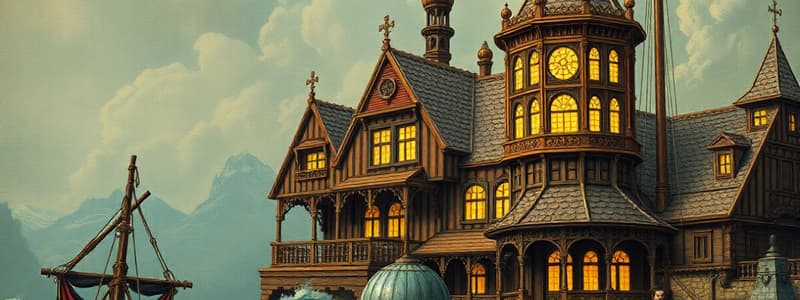Podcast
Questions and Answers
During which centuries did the Great Exploration primarily occur?
During which centuries did the Great Exploration primarily occur?
- 16th to 17th Century
- 14th to 15th Century
- 15th to 16th Century (correct)
- 17th to 18th Century
What was a significant event that prompted Europeans to seek new trade routes to Asia?
What was a significant event that prompted Europeans to seek new trade routes to Asia?
- The discovery of America
- The plague in Europe
- The invention of the compass
- The Turks taking over Constantinople (correct)
Which of the following countries was NOT involved in the Great Exploration?
Which of the following countries was NOT involved in the Great Exploration?
- Italy (correct)
- Spain
- France
- Portugal
What motivated Europeans to trade with Asia during the Great Exploration?
What motivated Europeans to trade with Asia during the Great Exploration?
What evidence suggests that the Vikings were the first European settlers in North America?
What evidence suggests that the Vikings were the first European settlers in North America?
What was one of Jacques Cartier's main objectives during his voyages?
What was one of Jacques Cartier's main objectives during his voyages?
During his first voyage in 1534, what significant act did Cartier perform?
During his first voyage in 1534, what significant act did Cartier perform?
What notable event occurred during Cartier's second voyage in 1535?
What notable event occurred during Cartier's second voyage in 1535?
What misconception did Cartier have during his third voyage in 1541?
What misconception did Cartier have during his third voyage in 1541?
What was the outcome for the chief captured during Cartier's second voyage?
What was the outcome for the chief captured during Cartier's second voyage?
What significant discovery did John Cabot make in 1497?
What significant discovery did John Cabot make in 1497?
Why was the demand for fish particularly high in Europe?
Why was the demand for fish particularly high in Europe?
What economic activities did European fishermen engage in when they settled in Newfoundland?
What economic activities did European fishermen engage in when they settled in Newfoundland?
What items did Europeans barter with Indigenous people?
What items did Europeans barter with Indigenous people?
How did European arrival affect the Indigenous way of life?
How did European arrival affect the Indigenous way of life?
What was one major impact of European arrival on indigenous hunting practices?
What was one major impact of European arrival on indigenous hunting practices?
What was one reason Europeans were motivated to find a western sea route?
What was one reason Europeans were motivated to find a western sea route?
How did trade change among indigenous groups after Europeans arrived?
How did trade change among indigenous groups after Europeans arrived?
What was one of King Francis I's motivations for sending Jacques Cartier on his voyage?
What was one of King Francis I's motivations for sending Jacques Cartier on his voyage?
What role did missionaries play in the European exploration of indigenous lands?
What role did missionaries play in the European exploration of indigenous lands?
Flashcards
Great Exploration
Great Exploration
The period of time between the 15th and 16th centuries where European nations embarked on voyages of exploration and discovery, primarily driven by the desire for new trade routes to Asia.
Why did the Great Explorations occur?
Why did the Great Explorations occur?
The Ottoman Empire's capture of Constantinople in 1493 disrupted Europe's traditional trade routes to Asia, forcing them to seek alternative sea routes.
Who were the main players?
Who were the main players?
Spain, Portugal, Great Britain, and France were the major European powers involved in the Great Exploration.
Vikings: First Europeans in North America?
Vikings: First Europeans in North America?
Signup and view all the flashcards
Discovery of Great Fishing Banks
Discovery of Great Fishing Banks
Signup and view all the flashcards
What did John Cabot discover in 1497?
What did John Cabot discover in 1497?
Signup and view all the flashcards
Why did Europeans settle in Newfoundland?
Why did Europeans settle in Newfoundland?
Signup and view all the flashcards
Why was there high demand for fish in Europe?
Why was there high demand for fish in Europe?
Signup and view all the flashcards
How did Europeans learn about the fur trade?
How did Europeans learn about the fur trade?
Signup and view all the flashcards
Why did European trade with Indigenous people?
Why did European trade with Indigenous people?
Signup and view all the flashcards
Increased Hunting
Increased Hunting
Signup and view all the flashcards
Dietary Changes
Dietary Changes
Signup and view all the flashcards
Trade Disruptions
Trade Disruptions
Signup and view all the flashcards
Colonial Empire
Colonial Empire
Signup and view all the flashcards
Sea Route to Asia
Sea Route to Asia
Signup and view all the flashcards
Cartier's First Voyage (1534)
Cartier's First Voyage (1534)
Signup and view all the flashcards
Cartier's Second Voyage (1535)
Cartier's Second Voyage (1535)
Signup and view all the flashcards
Cartier's Third Voyage (1541)
Cartier's Third Voyage (1541)
Signup and view all the flashcards
Cartier's Missionary Efforts
Cartier's Missionary Efforts
Signup and view all the flashcards




